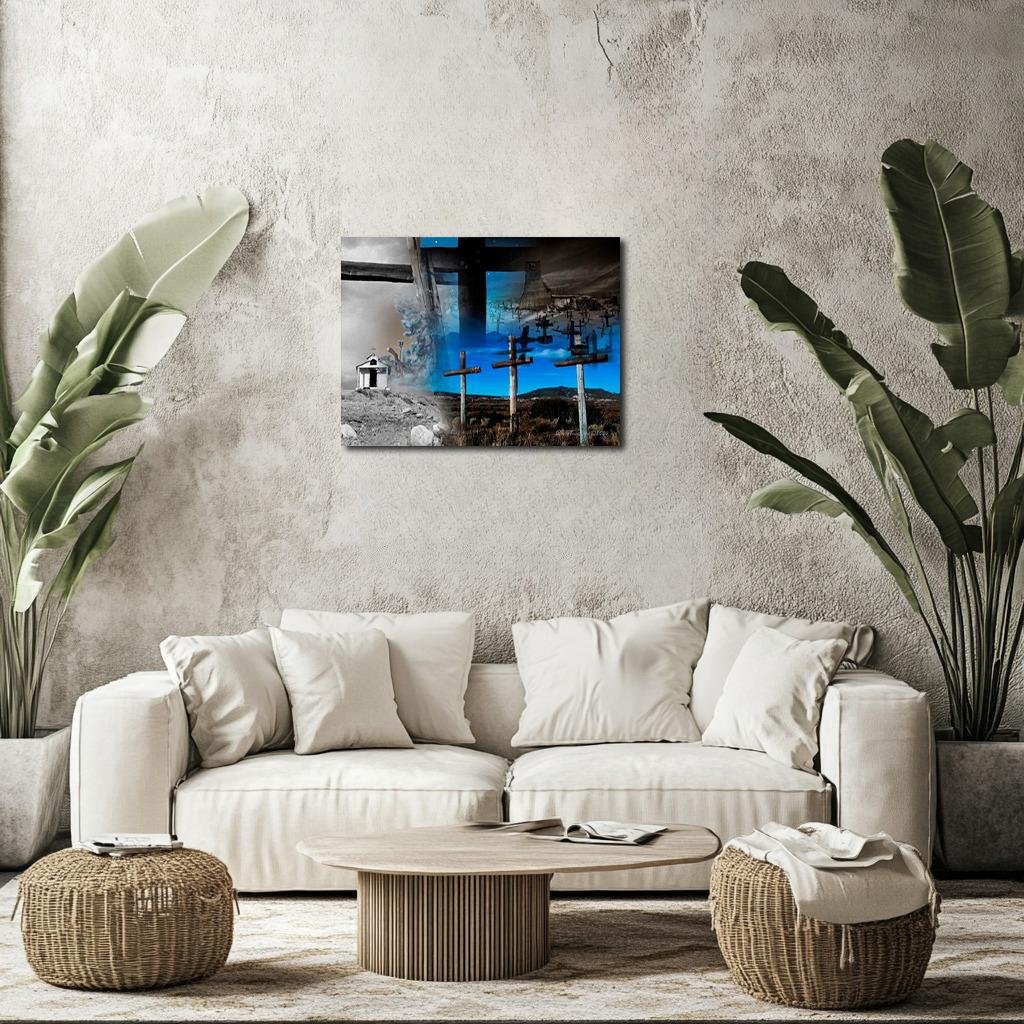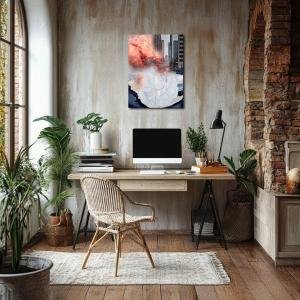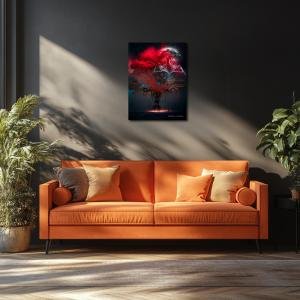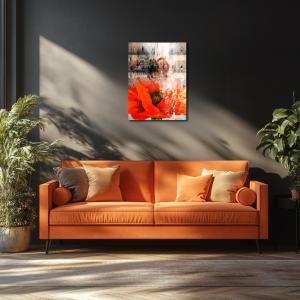Veil of Silence: Black Cross
Veil of Silence reimagines O’Keeffe’s Black Cross as a surreal meditation on death, memory, and spiritual endurance. Set in a twilight desert, wooden crosses multiply across a dissolving sky while a ghostly chapel fades into history. The deep cerulean center divides memory from presence, life from afterlife. Weathered wood, pale gold brush, and a gradient of black to blue evoke solemn reverence, while floating reflections transform the cross into a symbol of timeless mourning. This haunting collage blurs the line between sacred ground and silent sky—offering the cross not as salvation, but as steadfast witness to time’s quiet unraveling.
Please see Below for Details…
Hotline Order:
Mon - Fri: 07AM - 06PM
404-872-4663
Veil of Silence reinterprets Georgia O’Keeffe’s Black Cross, New Mexico as a dreamlike exploration of permanence, faith, and the silent gravity of death within the Southwestern landscape. This conceptual collage expands the solemnity of O’Keeffe’s original into a layered mirage of temporal collapse—where crosses stretch infinitely into a dissolving sky, and sacred structures blur between worlds. The once-isolated black cross becomes a resonant axis, multiplying across space and memory, each one echoing grief, reverence, and the austere poetry of New Mexico’s desert silence.
At the center, three dominant crosses rise out of a dry, gold-tinged brushland—weathered wood scarred by sun and time. Their stark verticality draws the eye upward, cutting into a sky that transitions from surreal blue into spectral black. These crosses do not simply mark a location—they mark memory, mourning, and the haunting persistence of belief. Behind them, O’Keeffe’s original adobe chapel and sky are split open—half fading into grayscale memory, the other projecting a surreal, dreamlike reflection of ghost towns, burial grounds, and distant mountains. This duality is central: life and afterlife, landscape and symbol, seen and unseen.
Color is used sparingly but with potent contrast. The foreground glows in quiet tones of wheat, sienna, and sun-faded ochre—evoking a parched but resilient land. The wood of the crosses leans toward ash-gray and silver-brown, textured like old bones. In contrast, the sky cuts a deep, surreal blue at its center—a spiritual rupture that feels neither day nor night, but something liminal, as if the heavens themselves were holding their breath. This piercing cerulean is framed by creeping dusk tones—violet, ink black, and soft pewter—gradually consuming the clarity like mourning swallowing memory.
On the left, a grayscale chapel stands alone, ghostlike, against a bleached sky. It anchors the composition in a time now past, filtered through the lens of black-and-white photography—a reference to how we enshrine memory in static relics. Cacti rise beside it like mourners, blurred in motion as if grieving in wind. This left side of the image suggests a forgotten world—sunburnt, emptied, yet sacred. The shift from black-and-white to vivid color becomes a statement on what fades versus what echoes eternally.
Above the chapel, crosses float across a mirrored sky, repeating like a chant. These forms aren’t grounded; they drift in a surreal field, each one a fragile tether to memory and faith. This multiplication transforms the solitary symbol into a chorus—a constellation of mourning. The chapel behind them is semi-erased, bleeding into cloud and rock, suggesting the erasure of physical faith, even as the symbolic cross remains.
The symbolism here is both cultural and cosmic. O’Keeffe’s original cross was a tribute to the spiritual presence of the New Mexican landscape, standing tall against the elemental vastness of the sky. In Veil of Silence , that spiritual presence is expanded into a metaphysical map. The cross is not just a Christian symbol, but a portal—one that connects the seen world with the unseen, life with land, permanence with the fleeting whisper of breath. It stands, not as a beacon, but as a still witness.
The right side of the composition mirrors the left in eerie inversion. The crosses now appear as reflections, drifting across the sky like memories seen through water. Their wooden limbs are less defined, more abstract—almost dissolving into the clouds. The mountain behind them is cloaked in soft mist, as though earth and sky were folding into one another. This is a world post-sunset, post-suffering—where the icons we cling to begin to vanish into air.
In creating Veil of Silence , I sought to honor O’Keeffe’s quiet reverence for the land and its sacred emblems, while deepening the psychological space around the cross. The cross here is not triumphant—it is contemplative. It is not merely religious, but deeply human. A marker. A wound. A shadow held in light. Time bends around it. Memory flows through it. It becomes the stillest thing in a moving world.
This piece also speaks to the erosion of cultural permanence—the chapel collapsing into dust, the sky filled with ghost crosses, the blackness creeping in. Yet the central cross remains. It is cracked, yes, and weathered. But it remains. In its silent posture, it tells us what survives is not glory, but witness.
Add your review
Your email address will not be published. Required fields are marked *
Please login to write review!
Looks like there are no reviews yet.








